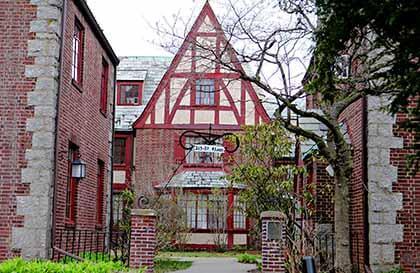By rich bockmann
The neo-Tudor style Hawthorne Court apartment complex is being heralded by many in the community as a fine example of the work of one of Queens’ more under-appreciated but significant architects. The apartment complex, at the corner of 216th Street and 43rd Avenue in Bayside, is being considered for landmark status by the city.
In a common scenario, the principal owner of the property, Esther Levenbrown of Teaneck, N.J., is opposed to the designation. A letter sent to Community Board 11 from her attorney states that many of the units in the apartment complex are either rent-controlled or stabilized and that a designation by the Landmark Preservation Commission could cause costs related to the maintenance of the exterior to double.
A public hearing on the proposal was held March 22, but CB 11 did not present testimony. In a written statement Bernard Haber, chairman of the board’s Landmarks Committee, said he did not receive information about the application with adequate time to prepare a position and cited years of frustration with what he called the LPC’s lack of protocol.
State Assemblyman Edward Braunstein (D-Bayside), the Bayside Historical Society, the Rego-Forest Preservation Council, the Historic Districts Council and the Queens Preservation Council submitted testimony in favor of designation.
No date has been set for a final LPC vote, but if approved the matter would go to the City Council, which usually defers such a decision to the local Council member. Councilman Dan Halloran (R-Whitestone) did not respond to a request for comment for his position on the issue.
According to the testimony provided to the LPC, Hawthorne Court is an example of the civic-minded, middle-class housing architect Benjamin Braunstein — no relation to the assemblyman — built throughout the borough in the earlier part of the 20th century. The Queens Chamber of Commerce awarded the ornate complex with first prize for “excellence in design and civic value” in 1931.
Marvin Mitzner, the attorney representing Levenbrown, wrote that Hawthorne Court is not particularly distinct among Braunstein’s other projects, many of which still exist in neighborhoods like Forest Hills.
“The reality is that, not only is the architect a person of little notoriety or historical importance in the architecture community, but Hawthorne Court is not even considered among the listings of his more prominent works.”
Reach reporter Rich Bockmann by e-mail at rbockmann@cnglocal.com or by phone at 718-260-4574.

































